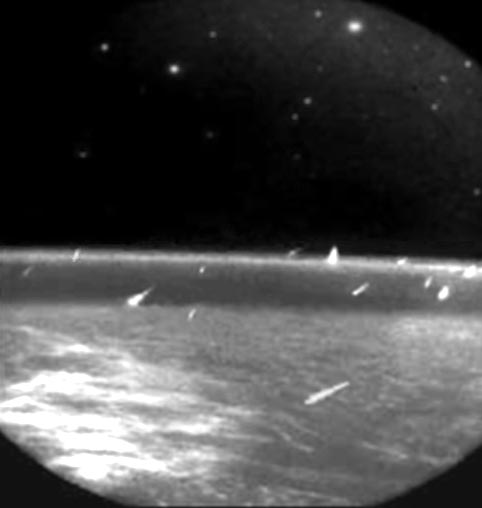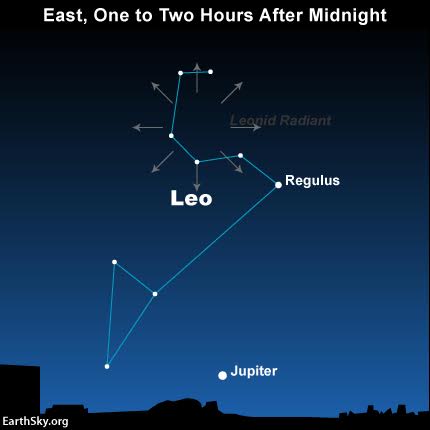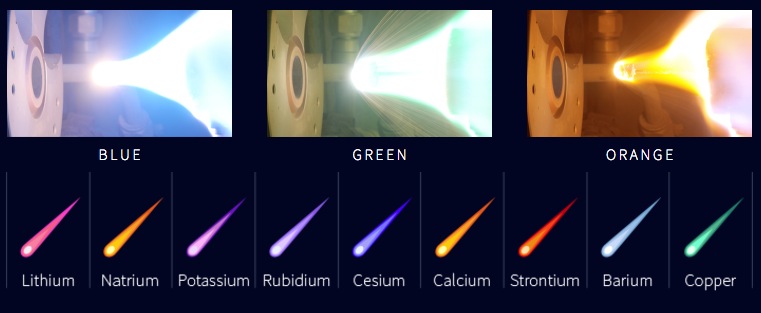November 16, 2016 8:00 pm
Tonight’s Leonid Meteor Shower and Answers to Common Questions about Meteors
This guest blog post is by StarTalk intern Kirk Long. Kirk is majoring in physics while minoring in mathematics and piano at Idaho State University.

A composite of Leonid meteor images recorded by a CCD camera onboard the MSX satellite. Credit: NASA.
It’s pretty easy to get caught up in worldly problems, especially in an election year, and while those problems are important one of the benefits of the cosmic perspective is it allows us a respite from the chaos and cacophony of the pale blue dot. As a budding astronomer, one of my favorite phenomena to relax and observe are meteor showers. The Leonid meteor shower is this month, and although it won’t be the most spectacular show of the year it has a fascinating history and comes at the perfect time after a stressful election, when many of us could use a refresher of our cosmic perspectives. (PS, if you’re interested, watch this funny take on that cosmic perspective from Neil and Stephen Colbert.)

Star map of the constellation Leo showing the Leonid Radiant, courtesy of EarthSky.org article linked to below.
The Leonids – named because meteors appear to radiate from the constellation Leo (see EarthSky’s Leonid’s guide) – will be at their peak in the early morning of the 17th. Unfortunately, the moon will still be about 80% illuminated (there’s a full “supermoon” on the 14th) and it will be up most of the night, washing out some of the fainter meteors we might otherwise see. The Leonids are predicted this year to fall at a rate of 10-20 an hour, although historically the Leonids have on occasion produced some of the most spectacular meteor storms in history. Leonid outbursts have occurred as recently as 1997-2001, where around 3,000 meteors fell at the peak each year, but the earliest and most spectacular Leonid outburst recorded happened in the fall of 1833. In 1833 there was an extraordinary showing – estimates place the meteor count between 100,000 and 240,000 meteors an hour – and for the first-time researchers began to take seriously the idea that “falling stars” were not mere atmospheric disturbances but the results of Earth plowing through cosmic debris. Studying meteor showers is a relatively imprecise science, but the Leonids were integral to fostering the discoveries that we have made. To this day we still have a lot of questions about meteor showers, and they are one of the most talked about astronomical events, especially to the general populace. During my summers off from school I volunteer at an observatory, and whenever there’s a meteor shower we see a spike in curious patrons who often have a lot of good questions to ask. Below I’ve outlined some of the most common questions I’ve heard over the years, and the answers I normally give to them. StarTalk fans are pretty smart, and I suspect you’ll already know the answers to a few of these, but it’s always good to brush up to impress the in-laws.
What gives meteors their color?
Short Answer: The composition of the meteor itself and its interaction with the atmosphere are what results in the different colors we see from Earth.
Long Answer: The color a meteor produces as it burns up in the atmosphere is mainly determined by two things – its speed and its chemical composition. Speed is important, because in general the faster a meteoroid is travelling the brighter it will be (if mass is taken out of the equation for said hypothetical meteoroid). Part of the light emitted by meteors is a result of the ionization of the atmosphere caused by the friction between itself and the meteoroid – the faster the meteor is travelling, the hotter the surrounding air is heated and compressed, and the more pronounced this effect is. The air then glows, emitting radiation depending on its composition – which is dependent on how high up in the atmosphere the interaction takes place. This same effect is what gives the aurora borealis its beautiful colors, and these colors emitted by the atmosphere are mainly the results of nitrogen (which makes up around 78% of the atmosphere) and oxygen (which makes up around 21% of the atmosphere).
Highly ionized oxygen will produce a greenish-yellow color (familiar to any aurora or meteor shower watcher) and a lower-energy ionization will produce a reddish color. Ionized nitrogen generally gives off a blue hue, and these emissions can mix and produce a wide variety of colors which change depending on what part of the atmosphere you are interacting with and thus the different percentages of oxygen and nitrogen at that point. A slower moving meteor might thus appear to be more reddish in color, and faster moving meteors can appear to leave greener trails of ionized gas in the atmosphere. The fastest moving meteors (like the Orionids last month) ionize the atmosphere so intensely that they often leave pockets of ionized atmospheric gas behind – persistent meteor trails that can be seen for a few seconds after the meteoroid itself has burned up.
The second important factor in what color a meteor might appear is due to the chemical composition of the meteoroid itself. As the cosmic debris is burned up in the atmosphere, its distinctive elemental components emit light as electrons become excited and start to jump around. Each element has a distinctive spectral signature (this analysis is called spectroscopy, and it is integral to our understanding of everything from the chemical makeup of distant stars to measuring the expansion of the universe) and thus emits a distinct color of light as it burns up. You may remember doing flame tests in high school or college chemistry courses where you were tasked to identify a particular compound simply on the color of flame it produced when burned, and the concept with identifying meteoroid composition is similar (although instead of a Bunsen burner these meteoroids are being burned up by the frictional force of impacting our atmosphere, which is pretty awesome). Below I’ve included a table showing the different colors you might observe a meteor to be, and what elements those colors correlate to.

Image courtesy of the Sky Canvas project at http://global.star-ale.com/project/visual.
Why do many meteor showers happen annually? Will they ever stop?
Short Answer: Comets shed layers of gas, dust, and rock when they approach the sun. It turns out they leave a lot of stuff for us to hit!
Long Answer: Comets are icy, cold bodies normally in deep space – some of the leftovers from the early days of our solar system. They follow highly eccentric orbits, which means that although the majority of their lives are spent astronomically far away from the sun, occasionally they swing incredibly close to our star. As they approach the sun, they are rapidly heated and their ice turns to gas. As this water vaporizes and leaves the comet, it takes bits of dust and rock with it, almost like little geysers. Each time a comet swings by the sun, it leaves a trail of ejected particulate, and over time many of these filaments are laid down, waiting for the Earth to plow through them. The other planets (especially Jupiter) influence these filaments and put them into predictable paths, so that each year we plow through the remains of the same comets. Fine adjustments in the filaments positions and other factors such as radiation pressure (discussed more below) ensure that each year there are still particles for us to hit. Eventually, the comets laying down filaments might disintegrate and eventually we might plow through all of the matter left behind by their slow destruction, but these processes operate on a cosmic timescale and thus you probably don’t have to worry too much about your favorite meteor shower disappearing anytime soon. The Leonid meteor shower filaments are the results of material shed by the comet 55P/Tempel-Tuttle, which is a comet with a relatively short orbit of only 33 years.
Why are meteor showers so hard to predict?
Short Answer: Most meteoroids are really small, they can be difficult to observe, and orbital mechanics is really complicated.
Long Answer: One of the most common sentiments I get at the observatory from meteor watchers is disappointment. They travel all the way out to visit us where the skies are dark and the seeing is good, only to find that the meteor “shower” they have come to watch isn’t quite the once in a lifetime show they were sold on by the media. A common question I get asked is “if we can predict the orbit/position of the planets/satellites/spacecraft so accurately, why can’t we do the same for meteor showers?” Calculating the precise orbits of the particulate filaments left behind by comets (discussed above) is trickier than calculating the orbits of the planets for a few reasons. First, they are composed almost entirely of pieces of dust often smaller than a grain of sand, making them difficult to observe. Second, and more importantly, even when they are observed it is much more difficult to precisely predict their orbital motion due to their tiny mass. Planets are huge, and are largely impervious to the effects of radiation or the other planets. Kepler’s equations of orbital motion work very nicely on the planets because there are many fewer variables to worry about. We don’t have to worry a whole lot about the Earth being pushed out of its orbit by sunlight, but with tiny meteors the effect of simple radiation emitted by the sun can have a significant impact on their orbits. Likewise, because of their smaller masses they are more susceptible to being influenced by large gravitational masses, in particular Jupiter, and without incredibly detailed and precise measurements of the filament itself these orbital variations are impossible to predict precisely. We can get a good estimate, but sometimes our models and predictions fail. That’s not always a bad thing though – just as frequently as shows that disappoint are showers that turn out to be spectacular when they were originally predicted to be duds.
Do you have other questions on meteors that weren’t covered here? Let us know in the comments.
Get the most out of StarTalk!
Ad-Free Audio Downloads
Ad-Free Video Episodes
Stickers & Mugs
Live Streams with Neil
Priority Cosmic Queries
Early-Access Videos
Learn the Meaning of Life
...and much more

 Become a Patron
Become a Patron

